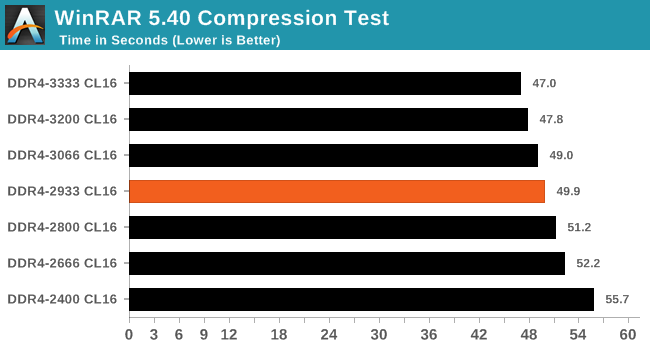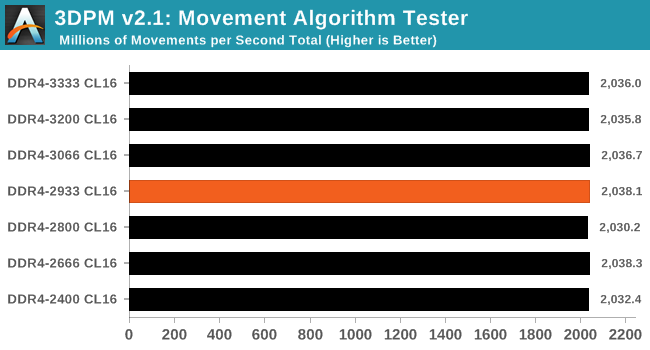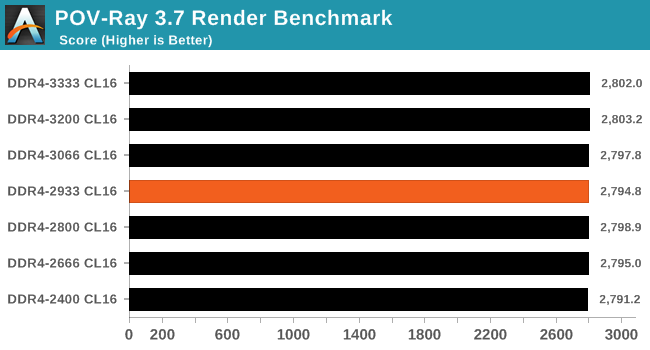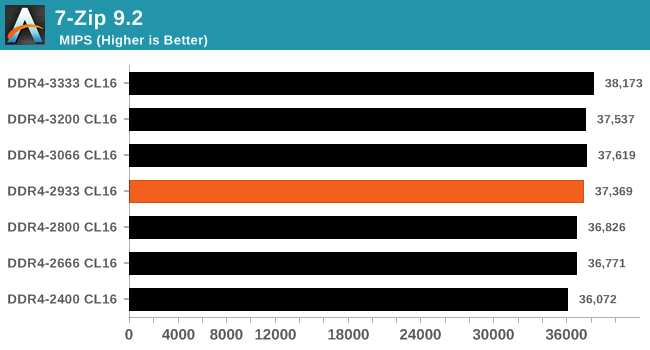Memory Scaling on Ryzen 7 with Team Group's Night Hawk RGB
by Ian Cutress & Gavin Bonshor on September 27, 2017 11:05 AM ESTCPU Performance, Short Form
For our quick reviews, we use our short form testing method.
Video Conversion – Handbrake v1.0.2: link
Video transcoding (both encode and decode) is a hot topic in performance metrics as more and more content is being created. First consideration is the standard in which the video is encoded, which can be lossless or lossy, trade performance for file-size, trade quality for file-size, or all of the above can increase encoding rates to help accelerate decoding rates. Alongside Google's favorite codec, VP9, there are two others that are taking hold: H264, the older codec, is practically everywhere and is designed to be optimized for 1080p video, and HEVC (or H265) that is aimed to provide the same quality as H264 but at a lower file-size (or better quality for the same size). HEVC is important as 4K is streamed over the air, meaning less bits need to be transferred for the same quality content.
Handbrake is a favored tool for transcoding, and so our test regime takes care of three areas.
Low Quality/Resolution H264: Here we transcode a 640x266 H264 rip of a 2 hour film, and change the encoding from Main profile to High profile, using the very-fast preset.

High Quality/Resolution H264: A similar test, but this time we take a ten-minute double 4K (3840x4320) file running at 60 Hz and transcode from Main to High, using the very-fast preset.

HEVC Test: Using the same video in HQ, we change the resolution and codec of the original video from 4K60 in H264 into 4K60 HEVC.

The biggest gains in Handbrake came in the HQ test where we gained up to an extra +21% in performance for DDR4-3333 over DDR4-2400. The fact that we don't see the same gains in the HEVC test is likely down to the algorithm.
Compression – WinRAR 5.40: link
For the 2017 test suite, we move to the latest version of WinRAR in our compression test. WinRAR in some quarters is more user friendly that 7-Zip, hence its inclusion. Rather than use a benchmark mode as we did with 7-Zip, here we take a set of files representative of a generic stack (33 video files in 1.37 GB, 2834 smaller website files in 370 folders in 150 MB) of compressible and incompressible formats. The results shown are the time taken to encode the file. Due to DRAM caching, we run the test 10 times and take the average of the last five runs when the benchmark is in a steady state.

Like with Handbrake, the system seemed to scale pretty well in WinRAR with a ~16% performance gain going from DDR4-2400 to DDR4-3333.
3D Movement Algorithm Test v2.1
This is the latest version of the self-penned 3DPM benchmark. The goal of 3DPM is to simulate semi-optimized scientific algorithms taken directly from my doctorate thesis. Version 2.1 improves over 2.0 by passing the main particle structs by reference rather than by value, and decreasing the amount of double->float->double recasts the compiler was adding in. It affords a ~25% speed-up over v2.0, which means new data.

Although more of a raw CPU benchmark, it shows here that memory isn’t a massive factor, as regardless of memory speed, we encountered marginal performance gains.
POV-Ray 3.7: link
Another regular benchmark in most suites, POV-Ray is another ray-tracer but has been around for many years. It just so happens that during the run up to AMD's Ryzen launch, the code base started to get active again with developers making changes to the code and pushing out updates. Our version and benchmarking started just before that was happening, but given time we will see where the POV-Ray code ends up and adjust in due course.

POV-Ray might be a fruitful benchmark for testing memory stability, but our performance variation between memory speeds was within the margin of error.
7-Zip 9.2: link
One of the freeware compression tools that offers good scaling performance between processors is 7-Zip. It runs under an open-source licence, is fast, and easy to use tool for power users. We run the benchmark mode via the command line for four loops and take the output score.

Some compression tools can be susceptible to memory performance and it shows in our results such as WinRAR. 7-zip has a small performance boost as we rise up through the stack, although the differences above DDR4-2666 are fairly minimal.










65 Comments
View All Comments
notashill - Wednesday, September 27, 2017 - link
There's a new AGESA 1.0.0.6b but AMD has said very little about what changed in it.JocPro - Wednesday, September 27, 2017 - link
According to page 3, how come 2933 MT/s (67 MT/s apart of the rated bandwidth) is *nearest* to the kit's rating, if 3066 MT/s is just 66 MT/s apart of the kit's rating?DanNeely - Wednesday, September 27, 2017 - link
Because rounding. They're 2933.33333.... and 3066.66666..... Both are 66.6666.... off and XMP (which is how the DIMM maker specifies what to do) rounds to the lower one not the higher one.DanNeely - Wednesday, September 27, 2017 - link
In theory anyway. In practice manufacturing variance (not sure if CPU or mobo) means the step size won't be exactly 133.3333.... but rather slightly higher or lower than that value.FreckledTrout - Wednesday, September 27, 2017 - link
For those prices I would rather pick up G Skill Flare x running at 3200Mhz and CAS14 ($190 on newegg).qlum - Wednesday, September 27, 2017 - link
While it is an older lgame it would have been interesting to see fallout 4 included here as it is notorious for its memory scalingOutlander_04 - Wednesday, September 27, 2017 - link
I am curious about the use of such an old graphics card. Surely an nVidia 10xx card, or RX vega was availableLolimaster - Wednesday, September 27, 2017 - link
Come one, people are running 3200 CL14 on Ryzen for many months, why test with a puny CL16.This should also include DDR4 3600-4000 with many brands.
Nagorak - Thursday, September 28, 2017 - link
Few have even managed to get 3600 MHz stable with Ryzen, let alone anything more than that. Even 3466 isn't a given for many boards/processors.CheapSushi - Thursday, September 28, 2017 - link
I think it is time for RAM to go the QDR route (quad data rate) instead for upcoming DDR5. It's already proven and workable in SRAM and GDDR5X (it's QDR despite the name. This would be a MUCH more significant improvement in latency and I/O than the paltry MHz bump DDR5 will do. I think AMD's Zen architecture would benefit and go even further with QDR for next gen.Image of QDR vs DDR: https://upload.wikimedia.org/wikipedia/commons/thu...
Image of QDR vs DDR: http://image.slideserve.com/1303208/qdr-class-vs-d...